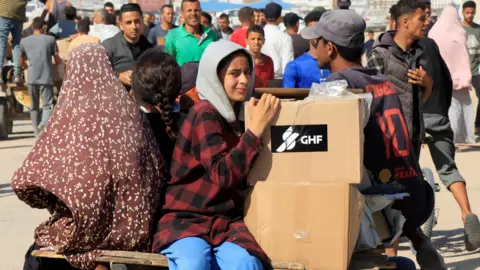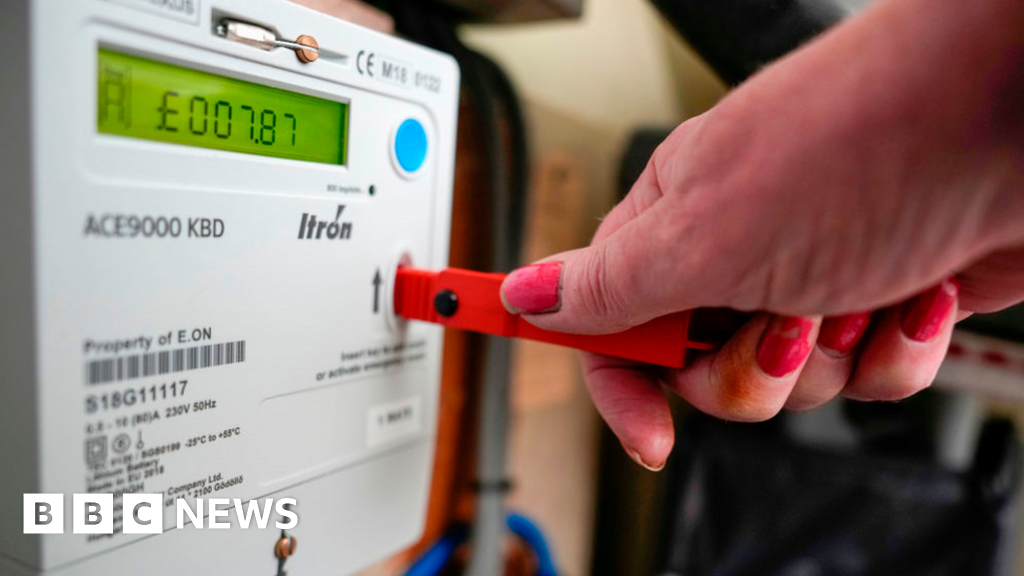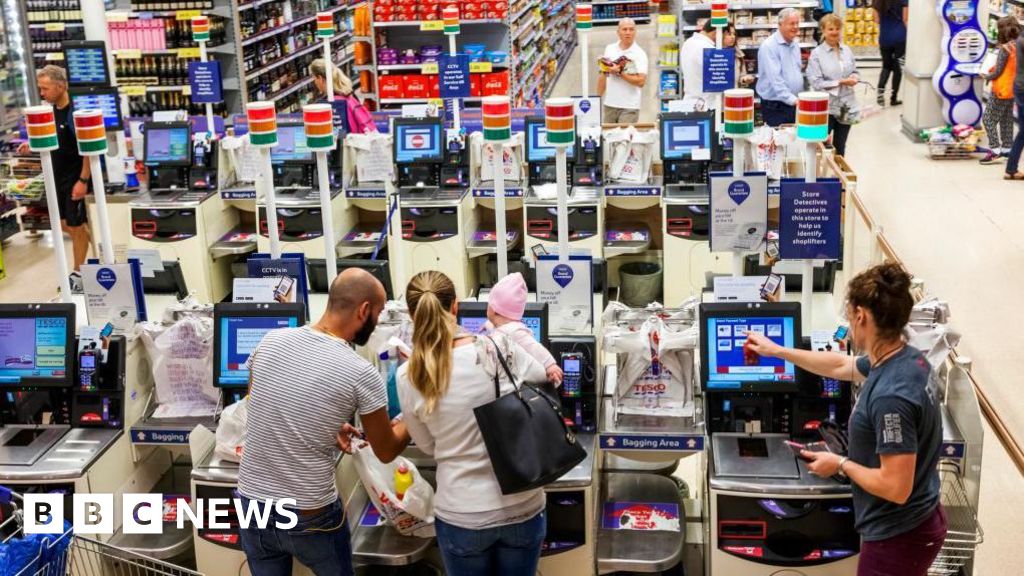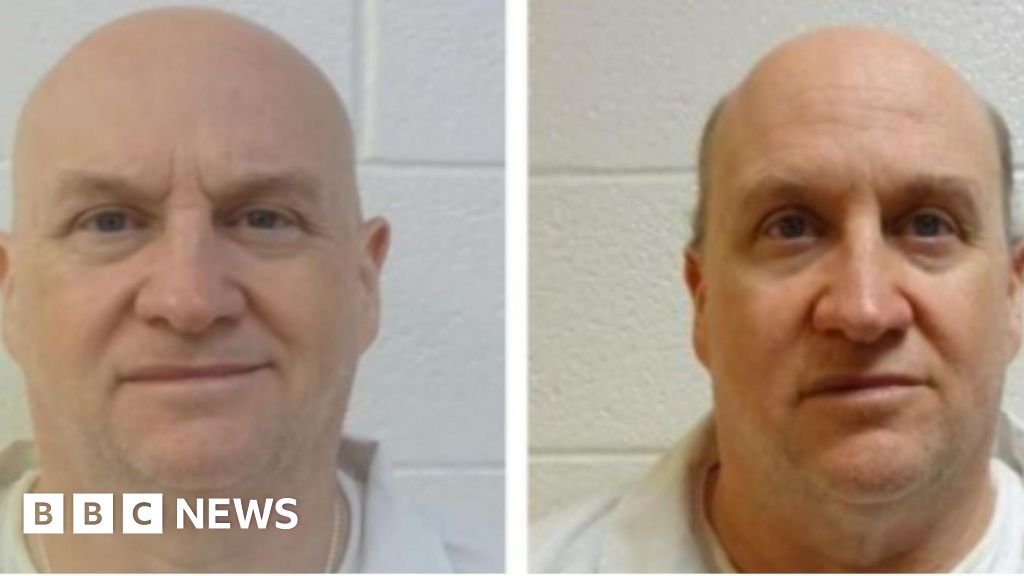Thousands of Gazan's stampede towards a food distribution centre
Crowds of Palestinians have overrun a distribution site in Gaza set up by a controversial US and Israeli-backed group, a day after it began working there.
Videos showed people walking over torn-down fences and earth berms at the Gaza Humanitarian Foundation's (GHF) compound in the southern city of Rafah.
The group said that at one point its team fell back because the numbers seeking aid was so great. The Israeli military said troops nearby fired warning shots.
The GHF, which uses armed American security contractors, aims to bypass the UN as the main supplier of aid in Gaza, where experts have warned of a looming famine after an 11-week Israeli blockade that was recently eased.
The UN said the videos from Rafah were "heartbreaking" and that it had a detailed plan ready to get enough aid to the 2.1 million population.
The UN and many aid groups have refused to co-operate with GHF's plans, which they say contradict humanitarian principles and appear to "weaponise aid".
They have warned that the system will practically exclude those with mobility issues, force further displacement, expose thousands of people to harm, make aid conditional on political and military aims, and set an unacceptable precedent for aid delivery around the world.
Israel has said an alternative to the current aid system is needed to stop Hamas stealing aid, which the group denies doing.
The GHF announced on Monday that it had "commenced operations in Gaza" and begun giving out supplies to Palestinians at its distribution sites.
On Tuesday afternoon, the Israeli military confirmed two sites located in the Tal al-Sultan neighbourhood of Rafah and the Morag Corridor - an east-west military zone that separates the city from the rest of Gaza - had begun distributing food to families.
At around the same time, Israeli and Palestinian media shared pictures showing long queues of Palestinians at the Tal al-Sultan site.
But just over an hour later, they began posting videos showing thousands of men, women and children streaming into the compound. In one clip, some people are seen running and ducking as what appear to be gunshots ring out.
Witnesses described a scene of chaos as people seized food parcels and other aid from the site. They also said Israeli troops stationed nearby had opened fire.
"The situation was extremely difficult. They only allowed 50 people to cross at a time," one man told BBC Arabic's Middle East daily radio programme. "In the end, chaos broke out - people climbed over the gates, attacked others, and took all the [aid]."
"It was a humiliating experience," he added. "We've suffered greatly from hunger. We're just looking for a bit of sugar to make a cup of tea, and a piece of bread to eat."
A woman said hunger and poverty had "overwhelmed everyone".
"People are exhausted - willing to do anything, even risk their lives - just to find food and feed their children."
A statement from the GHF acknowledged that "the needs on the ground are great" and said it had so far handed out about 8,000 food boxes - each meant to feed five-and-a-half people for three-and-a-half days - through a partnership with local non-governmental organisations.
However, it said Palestinians had experienced several hours of delays in accessing one site "due to blockades imposed by Hamas".
"At one moment in the late afternoon, the volume of people at the SBS [Secure Distribution Site] was such that the GHF team fell back to allow a small number of Gazans to take aid safely and dissipate. This was done in accordance with GHF protocol to avoid casualties. Normal operations have resumed," it added.
The Israel Defense Forces (IDF) said its troops had fired "warning shots in the area outside the compound".
"Control over the situation was established, food distribution operations are expected to continue as planned, and the safety of IDF troops was not compromised," it stated.
Gaza's Hamas-run Government Media Office said Israel's efforts to distribute aid had "failed miserably".
At a news conference in New York, UN spokesman Stéphane Dujarric said: "We have been watching the video coming out of Gaza around one of the distribution points set up by the Gaza Humanitarian Foundation. And frankly, these videos, these images, are heartbreaking."
"We and our partners have a detailed, principled, operationally sound plan supported by member states to get aid to a desperate population. We continue to stress that a meaningful scale-up of humanitarian operations is essential to stave off famine and meet the needs of all civilians wherever they are," he added.
The US state department's spokeswoman called the UN's criticism "the height of hypocrisy".
"It is unfortunate, because the issue here is giving aid to Gaza, and then suddenly it moves into complaints about style or the nature of who's doing it," Tammy Bruce told reporters.

 Reuters
Reuters
The GHF says it plans to feed a million people in Gaza by the end of this week
The GHF initially plans to set up four distribution sites in southern and central Gaza where Palestinians will be able to collect food and other aid for their families. It says it aims to feed a million people - just under half the population - by the end of this week.
The sites are meant to be secured by American contractors, with Israeli troops patrolling the perimeters. To access them, Palestinians are expected to have to undergo identity checks and screening for involvement with Hamas.
UN and other aid agencies have insisted they will not co-operate with any scheme that fails to respect fundamental humanitarian principles of humanity, impartiality, independence and neutrality.
On Sunday night, Jake Wood resigned as the GHF's executive director, saying the group's system could not work in a way that would be able to fulfil those principles.
The GHF's board rejected the criticism and accused "those who benefit from the status quo" of being more focused on "tearing this apart than on getting aid in".
The group also alleged on Monday that Hamas had made death threats to NGOs supporting its distribution sites and attempted to block civilians from accessing the aid.
Hamas has publicly warned Palestinians not to co-operate with GHF's system.
Israel imposed a total blockade on humanitarian aid and commercial supplies to Gaza on 2 March and resumed its military offensive two weeks later, ending a two-month ceasefire with Hamas. It said the steps were meant to put pressure on the armed group to release the 58 hostages still held in Gaza, up to 23 of whom are believed to be alive.
On 19 May, the Israeli military launched an expanded offensive that Prime Minister Benjamin Netanyahu said would see troops "take control of all areas" of Gaza. The plan reportedly includes completely clearing the north of civilians and forcibly displacing them to the south.
Netanyahu also said Israel would temporarily ease the blockade and allow a "basic" amount of food into Gaza to prevent a famine, following pressure from allies in the US.
Since then, Israeli authorities say they have allowed at least 665 lorry loads of humanitarian aid, including flour, baby food and medical supplies, into Gaza.
However, the head of the UN's World Food Programme warned on Sunday that the aid was only a "drop in the bucket" of what was needed in the territory to reverse the catastrophic levels of hunger, amid significant shortages of basic foods and skyrocketing prices.
Half a million people face starvation in the coming months, according to an assessment by the UN-backed Integrated Food Security Phase Classification (IPC).
Israel launched a military campaign in Gaza in response Hamas' cross-border attack on 7 October 2023, in which about 1,200 people were killed and 251 others were taken hostage.
At least 54,056 people have been killed in Gaza since then, including 3,901 over the past 10 weeks, according to the territory's Hamas-run health ministry.

 1 day ago
7
1 day ago
7















 English (US) ·
English (US) ·